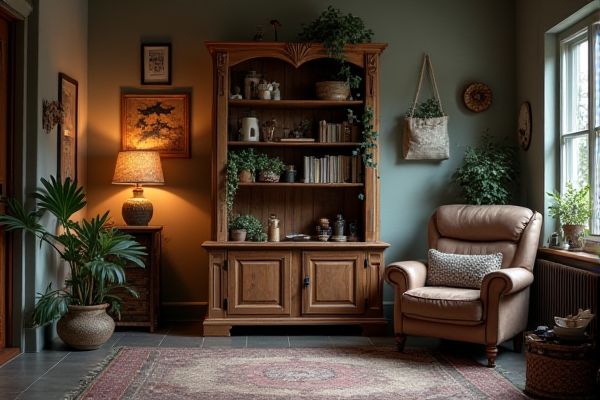
Choosing between a bird house and a bat house depends on your backyard's ecosystem and the types of wildlife you wish to attract or support. Explore the benefits and design features of each to determine which best suits Your outdoor habitat needs. Read on to learn more.
Table of Comparison
| Feature | Bird House | Bat House |
|---|---|---|
| Purpose | Provides nesting space for birds | Provides roosting space for bats |
| Design | Small box with entrance hole, often ventilated | Rectangular, narrow slits for bats to cling to |
| Materials | Wood, typically untreated | Wood, rough interior surface preferred |
| Placement | Mounted 5-10 feet above ground, away from predators | Mounted 10-20 feet high, in sunny locations |
| Target Species | Small birds like bluebirds, chickadees, wrens | Insectivorous bats such as little brown bat |
| Environmental Benefit | Supports bird populations and pest control | Controls insect populations, reduces mosquitoes |
| Maintenance | Clean annually to prevent parasites | Minimal disturbance preferred; check seasonally |
Understanding Bird Houses and Bat Houses
Bird houses and bat houses serve distinct purposes by providing shelter for different species with unique habitat requirements. Bird houses typically feature smaller compartments and openings suited for nesting birds, while bat houses have larger, vertical roosting chambers designed to accommodate bat colonies. Understanding these structural differences helps you select the appropriate habitat to support local wildlife effectively.
Key Differences Between Bird Houses and Bat Houses
Bird houses are designed with small entry holes and compartments to accommodate various bird species, promoting ventilation and protection from predators. Bat houses feature narrow, vertical slits and smooth interior surfaces to support bats' roosting habits and provide a dark, secure environment. Understanding these structural differences helps you create suitable habitats that meet the specific needs of birds or bats in your area.
Design and Structural Features
Bird houses typically feature small entrance holes and perches designed to accommodate species-specific nesting habits, offering protection from predators and weather. Bat houses have smooth, roughened interiors and narrow slots to support bats' clinging behavior without damage to their wings. Your choice between the two should consider these structural differences to provide an optimal habitat tailored to the intended occupants.
Ideal Locations for Installation
Bird houses thrive when installed in quiet areas with ample tree cover, ideally 5 to 10 feet above the ground to protect from predators and provide shelter. Bat houses require placement in sunny spots receiving at least 6 hours of direct sunlight daily, mounted 12 to 20 feet high on buildings or poles to encourage roosting while avoiding disturbances. Both structures should be situated away from heavy foot traffic and strong winds to maximize occupancy and safety for the inhabitants.
Benefits of Bird Houses in Your Garden
Bird houses provide essential shelter for native bird species, promoting biodiversity and natural pest control in your garden. They attract pollinators and seed dispersers that enhance plant growth and ecosystem health. Installing bird houses supports local bird populations and increases opportunities for birdwatching and environmental education.
Ecological Advantages of Bat Houses
Bat houses provide critical roosting habitats that support bat populations, which are essential for controlling insect pests and reducing the need for chemical pesticides, thereby promoting natural pest management. Unlike bird houses, bat houses contribute significantly to biodiversity by supporting nocturnal pollinators and seed dispersers, which sustain various ecosystems. Installing bat houses enhances local agricultural productivity due to bats' role in pest control and supports ecological balance through the conservation of these beneficial mammals.
Common Birds and Bats That Use These Shelters
Common birds that use bird houses include bluebirds, chickadees, and wrens, which prefer cavities for nesting and protection. Bat houses are often inhabited by little brown bats, big brown bats, and Mexican free-tailed bats, providing them critical roosting sites. Both structures support local ecosystems by offering safe habitats for these important insect-eating species.
Maintenance and Upkeep Requirements
Bird houses generally require more frequent maintenance than bat houses because bird nests accumulate debris and feathers, necessitating seasonal cleaning to prevent parasites and mold. Bat houses, while needing less frequent cleaning, still require annual inspections to check for structural damage and to ensure they remain free of predators and pests. Proper upkeep of your chosen house will extend its lifespan and provide a safe environment for wildlife.
Tips for Attracting Birds or Bats
To attract birds, choose bird houses with appropriate entrance hole sizes matching target species, position them 5 to 30 feet above ground away from predators, and ensure proper ventilation and drainage. Bat houses should be mounted at least 12 to 20 feet high on buildings or poles, preferably in warm, sunny locations receiving six to eight hours of direct sunlight daily, with rough interior surfaces for roosting. Both bird and bat houses benefit from placement near natural food sources, clean water, and minimal disturbances to increase occupancy rates.
Choosing the Right Shelter for Your Yard
Choosing the right shelter for your yard depends on attracting specific wildlife, as bird houses provide safe nesting spots for various songbirds, while bat houses support local bat populations crucial for insect control. Consider the species common to your area, their preferred habitat conditions, and the size of the shelter to enhance occupancy rates. Your yard can benefit ecologically and visually by selecting the appropriate structure that meets the needs of either birds or bats.
 homyna.com
homyna.com